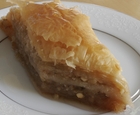|
Turkish Dessert Baklava Personally? I would buy this! But for those adventurous souls with good arches and sturdy legs, this is a great recipe.
40 sheets filo pastry, 2 boxes (thaw according to Syrup & Filling: first, prepare syrup by combining sugar, water and lemon juice in a saucepan. Stir to dissolve sugar, bring to a boil, and add rosewater. Do not stir once syrup reaches a boil (it may cloud); simply remove from heat and cool. In a separate bowl, combine nuts and spices with sugar and set aside. Pastry*: preheat oven to 350. Grease a 9 x 13 baking pan. Stack filo sheets on a flat surface and trim to fit baking pan. Layer 12 sheets in greased pan, brushing the top of each sheet with melted butter before adding the next. Top those sheets with remaining of nut mixture and add the final 12 sheets, buttering each individually. Brush the top sheet with the remaining butter. (You will have four separate filo layers: 12-8-8-12.) Baking: Before baking, cut pastry into 2” diamond shaped pieces, being sure to cut all the way through. Bake 30 minutes at 350—then reduce heat to 200 and bake another 30 minutes. Remove from oven and pour syrup over warm pastry. It should rest for several hours before serving. *While working with one sheet of filo, cover others with a slightly damp towel, or plastic, to prevent them from drying out. |
Tips & Glossary You may not have all the ingredients used in Turkish cooking on your spice shelf, but you'll find them at Middle-East food stores. To avoid frustration, make a list of items you need before trying out the recipes. Cumin: an aromatic, kin to parsley and carrots; an important ingredient in chili powder. Used especially in Indian curries, as well as in Mid-Eastern, Mexican, and Asian dishes. It has an earthy, peppery flavor. Filo: aka phyllo, paper-thin sheets of raw, unleavened flour dough. Buy frozen in any grocery store and follow directions on package for thawing. When working with one sheet, keep others covered with a damp towel to prevent drying out. Peeled Tomatoes: choose 1 of 2 methods: 1) hold tomatoes one-at-a-time over gas flame till skin bubbles and becomes charred; 2) drop all tomatoes into pot of boiling water for 45 seconds. After either method, run tomatoes under running water; skins will slip off easily. Roasted peppers: buy them prepared. Or make your own: place peppers under a broiler, or hold over a gas flame, till skin chars and blisters. Place them in a closed paper bag for 15-20 minutes (to steam them). When cool enough to handle, the skins slip off under running water. Rosewater: distilled from rose petals and used to flavor Mid-Eastern and Asian cooking. You can make your own—but why? Purchase it at Mid-East or Asian or food stores. Saffron: the most expensive spice in the world, from the crocus plant, and cultivated in Iran and Spain. Along with its unusual taste, it adds a deep rich yellow color to food. Use a strand or two at a time and soak in warm water before using. Skewers: use metal or wooden skewers for kabobs. If wooden, be sure to soak them for 30 minutes before using to prevent them from catching on fire.
|
Site by BOOM
![]()
LitLovers © 2024

